迪斯尼神奇英语教案
- 格式:docx
- 大小:33.67 KB
- 文档页数:13
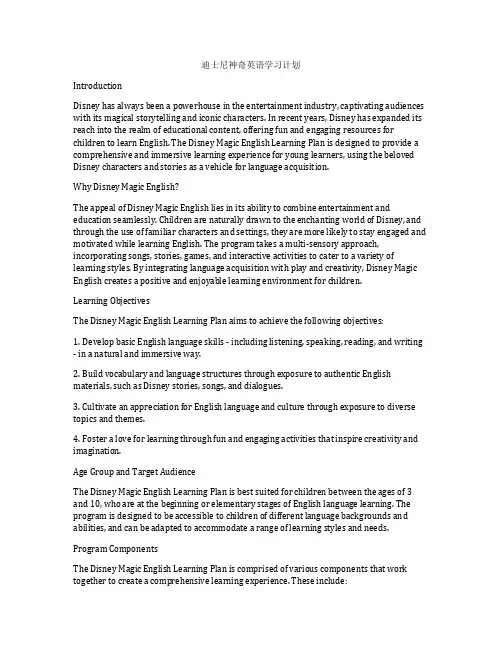
迪士尼神奇英语学习计划IntroductionDisney has always been a powerhouse in the entertainment industry, captivating audiences with its magical storytelling and iconic characters. In recent years, Disney has expanded its reach into the realm of educational content, offering fun and engaging resources for children to learn English. The Disney Magic English Learning Plan is designed to provide a comprehensive and immersive learning experience for young learners, using the beloved Disney characters and stories as a vehicle for language acquisition.Why Disney Magic English?The appeal of Disney Magic English lies in its ability to combine entertainment and education seamlessly. Children are naturally drawn to the enchanting world of Disney, and through the use of familiar characters and settings, they are more likely to stay engaged and motivated while learning English. The program takes a multi-sensory approach, incorporating songs, stories, games, and interactive activities to cater to a variety of learning styles. By integrating language acquisition with play and creativity, Disney Magic English creates a positive and enjoyable learning environment for children.Learning ObjectivesThe Disney Magic English Learning Plan aims to achieve the following objectives:1. Develop basic English language skills - including listening, speaking, reading, and writing - in a natural and immersive way.2. Build vocabulary and language structures through exposure to authentic English materials, such as Disney stories, songs, and dialogues.3. Cultivate an appreciation for English language and culture through exposure to diverse topics and themes.4. Foster a love for learning through fun and engaging activities that inspire creativity and imagination.Age Group and Target AudienceThe Disney Magic English Learning Plan is best suited for children between the ages of 3 and 10, who are at the beginning or elementary stages of English language learning. The program is designed to be accessible to children of different language backgrounds and abilities, and can be adapted to accommodate a range of learning styles and needs.Program ComponentsThe Disney Magic English Learning Plan is comprised of various components that work together to create a comprehensive learning experience. These include:1. DVD Series: The core of the program is a series of animated DVDs, each focusing on a specific theme or topic. Each DVD contains a collection of stories, songs, and interactive lessons that introduce vocabulary and language structures related to the theme. The visual and auditory nature of the DVDs provides a rich and engaging platform for language learning.2. Activity Books: Accompanying each DVD is an activity book that features exercises, games, and supplementary materials to reinforce the language learned from the videos. The activity books also serve as a resource for parents and educators to guide and assess the child's learning progress.3. Songs and Chants: The program incorporates catchy songs and chants that help children internalize language patterns and expressions. The repetitive nature of music aids in memory retention and pronunciation practice, making language learning more enjoyable and effective.4. Interactive Games and Play: Disney Magic English encourages hands-on learning through interactive games and play activities. These activities provide opportunities for active engagement and practice, allowing children to apply and reinforce their language skills in a playful and social setting.5. Parent and Teacher Guide: The program includes a guide for parents and teachers, offering tips, suggestions, and supplementary activities to support and extend the learning experience beyond the DVDs and activity books.Implementation StrategiesTo effectively implement the Disney Magic English Learning Plan, several strategies can be employed to create a supportive and enriching learning environment for children. These strategies include:1. Creating a Language-Rich Environment: Surround children with English language materials and resources, such as books, posters, and games, to expose them to the language in various contexts. Engage children in conversations and activities that encourage language use and exploration.2. Incorporating Multisensory Learning: Utilize a variety of sensory experiences, such as visual, auditory, and kinesthetic, to engage children in language learning. For example, use props, gestures, and role-play to reinforce vocabulary and language structures introducedin the DVDs.3. Encouraging Use of English in Daily Life: Encourage children to use English in their everyday interactions and activities, such as through greetings, simple conversations, and storytelling. Create opportunities for children to practice and apply what they have learned in meaningful and authentic ways.4. Providing Positive Reinforcement: Acknowledge and praise children for their efforts and progress in learning English. Use positive reinforcement, such as stickers, rewards, and verbal encouragement, to motivate and build confidence in their language abilities.5. Engaging in Cultural Exploration: Explore and celebrate the cultural aspects of the English language through exposure to English-speaking countries, traditions, and customs. Introduce children to diverse cultural elements through stories, songs, and activities to broaden their understanding and appreciation of the language and its cultural context.Assessment and MonitoringAssessment and monitoring are essential components of the Disney Magic English Learning Plan to track children's progress and identify areas for improvement. Various assessment methods can be used, including:1. Informal Observation: Observe children's language use, comprehension, and production during everyday activities and interactions. Take note of their abilities to understand and express themselves in English, and identify any patterns or recurring difficulties.2. Performance Tasks: Use activities and tasks from the activity books, such as matching exercises, puzzles, and role-plays, to assess children's language skills and understanding of the material covered in the DVDs. This can provide insight into their grasp of vocabulary, grammar, and pronunciation.3. Language Games: Monitor children's participation and performance in language games and activities, which can reveal their engagement, motivation, and level of language mastery.4. Parental Involvement: Engage parents in the assessment process by facilitating communication and feedback on their child's language learning journey. Share observations and progress with parents to foster a collaborative approach to support the child's language development.ConclusionThe Disney Magic English Learning Plan offers a captivating and effective method for children to learn English in a fun and engaging way. By leveraging the magic of Disney and its beloved characters, the program creates an immersive and enriching language learning experience that appeals to children's natural curiosity and enthusiasm. With a comprehensive approach that integrates storytelling, music, games, and interactive activities, Disney Magic English provides a solid foundation for children to develop their English language skills and cultivate a lifelong love of learning. As educators and parents, we can tap into the power of Disney to inspire and empower children on their journey to becoming confident and proficient English speakers.。
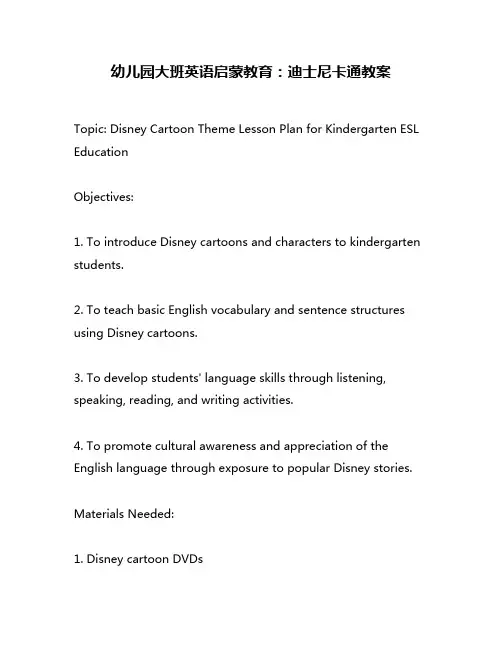
幼儿园大班英语启蒙教育:迪士尼卡通教案Topic: Disney Cartoon Theme Lesson Plan for Kindergarten ESL EducationObjectives:1. To introduce Disney cartoons and characters to kindergarten students.2. To teach basic English vocabulary and sentence structures using Disney cartoons.3. To develop students' language skills through listening, speaking, reading, and writing activities.4. To promote cultural awareness and appreciation of the English language through exposure to popular Disney stories.Materials Needed:1. Disney cartoon DVDs2. Flashcards with pictures of Disney characters3. Worksheets with Disney-themed activities4. Whiteboard and markers5. Storybooks with Disney stories6. Music player and Disney songsProcedure:Introduction (5 minutes)1. Greet the students and introduce the topic of the lesson.2. Show pictures of Disney characters such as Mickey Mouse, Minnie Mouse, Donald Duck, and Goofy, and ask the students if they recognize them.3. Play a short clip of a Disney cartoon to get the students excited about the lesson.Vocabulary (20 minutes)1. Present flashcards with pictures of different Disney characters.2. Pronounce the names of the characters and ask the students to repeat after you.3. Use the flashcards to teach basic English vocabulary such as colors, shapes, numbers, and animals.4. Play a game where students have to match the character to the correct name or vocabulary word.Listening (10 minutes)1. Play a short clip of a Disney song.2. Ask the students if they recognize the song and if they know the words.3. Play the song again and have the students sing along and dance.4. Use the song to teach basic English phrases and sentence structures.Speaking (15 minutes)1. Show the students a picture of a Disney character and ask them to describe it using adjectives.2. Have the students take turns asking and answering questions about their favorite Disney characters.3. Use the questions and answers to teach basic English conversation skills.Reading (15 minutes)1. Read a Disney storybook to the students.2. Ask comprehension questions to check their understanding.3. Use the story to teach basic English grammar and sentence structures.Writing (15 minutes)1. Hand out worksheets with Disney-themed activities such as coloring, tracing, and writing.2. Use the worksheets to reinforce the vocabulary and grammar taught in the previous activities.Closing (5 minutes)1. Review the vocabulary, grammar, and conversation skills taught in the lesson.2. Play another short clip of a Disney cartoon as a reward for their participation.3. Thank the students for their hard work and end the lesson.Assessment:1. Observe the students during the activities to assess their participation and understanding.2. Collect and grade the worksheets to assess their writing skills.3. Ask the students questions throughout the lesson to assess their comprehension and speaking skills.4. Provide feedback and praise for their efforts and progress.。
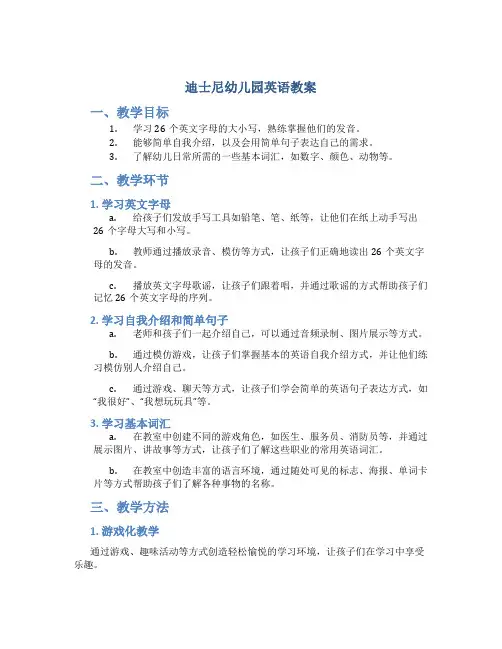
迪士尼幼儿园英语教案一、教学目标1.学习26个英文字母的大小写,熟练掌握他们的发音。
2.能够简单自我介绍,以及会用简单句子表达自己的需求。
3.了解幼儿日常所需的一些基本词汇,如数字、颜色、动物等。
二、教学环节1. 学习英文字母a.给孩子们发放手写工具如铅笔、笔、纸等,让他们在纸上动手写出26个字母大写和小写。
b.教师通过播放录音、模仿等方式,让孩子们正确地读出26个英文字母的发音。
c.播放英文字母歌谣,让孩子们跟着唱,并通过歌谣的方式帮助孩子们记忆26个英文字母的序列。
2. 学习自我介绍和简单句子a.老师和孩子们一起介绍自己,可以通过音频录制、图片展示等方式。
b.通过模仿游戏,让孩子们掌握基本的英语自我介绍方式,并让他们练习模仿别人介绍自己。
c.通过游戏、聊天等方式,让孩子们学会简单的英语句子表达方式,如“我很好”、“我想玩玩具”等。
3. 学习基本词汇a.在教室中创建不同的游戏角色,如医生、服务员、消防员等,并通过展示图片、讲故事等方式,让孩子们了解这些职业的常用英语词汇。
b.在教室中创造丰富的语言环境,通过随处可见的标志、海报、单词卡片等方式帮助孩子们了解各种事物的名称。
三、教学方法1. 游戏化教学通过游戏、趣味活动等方式创造轻松愉悦的学习环境,让孩子们在学习中享受乐趣。
2. 交互式教学让孩子们通过与老师、同伴的互动交流,巩固所学内容,提升语言学习效果。
3. 多模式教学通过多种不同的方式呈现课程内容,如音频、图片、视频等方式,满足孩子们不同的学习需求,提高教学效果。
四、教学效果评估通过以下方式评估每个孩子的学习效果:1.语言表达能力评估,如自我介绍、简单句子表达等。
2.听力理解能力评估,通过老师的口语指导和各种听力练习题,评估孩子们的听力理解程度。
3.日常生活实践,如颜色、数字、动物等的认知能力。
五、小结通过以上教学环节,迪士尼幼儿园的孩子们可以在轻松愉悦的环境中学习基本的英语字母、词汇和简单句型表达,并且在老师的引导下,积极地参与各种活动和游戏。
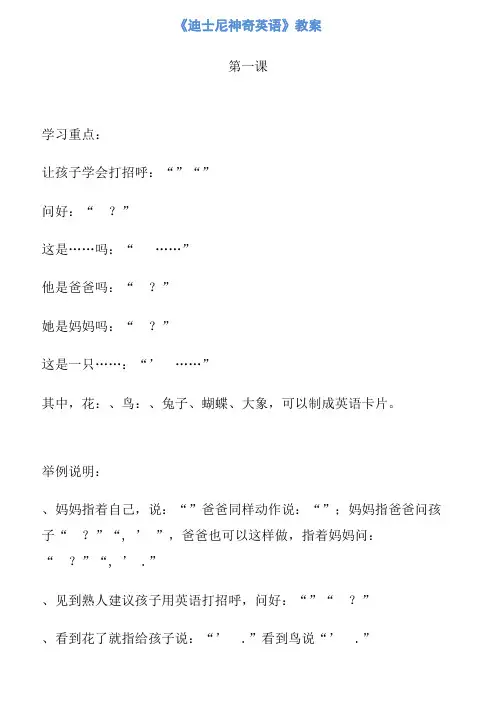
《迪士尼神奇英语》教案第一课学习重点:让孩子学会打招呼:“”“”问好:“?”这是……吗:“……”他是爸爸吗:“?”她是妈妈吗:“?”这是一只……:“’……”其中,花:、鸟:、兔子、蝴蝶、大象,可以制成英语卡片。
举例说明:、妈妈指着自己,说:“”爸爸同样动作说:“”;妈妈指爸爸问孩子“?”“, ’”,爸爸也可以这样做,指着妈妈问:“?”“, ’ .”、见到熟人建议孩子用英语打招呼,问好:“”“?”、看到花了就指给孩子说:“’ .”看到鸟说“’ .”第二课学习重点:她是母亲:“’”他是父亲:“’”……有个父亲:“……()”……有个母亲:“……()”……有个家:“……()”……有个姐姐:“……()”……有个哥哥:“……()”他高兴“’”她不高兴“’”或“’”其中,妈妈:、爸爸:、哥哥:、姐姐:、猫:,可以制成英语卡片。
举例说明:、早上可以让宝宝去叫爸爸起床“, ”、家里谁高兴的时候可以问孩子“’ ?”、家里人在一起的时候可以说:“、、’”第三课学习重点:他们在唱歌:“’”他们在跳舞:“’”你叫什么名字:“’?”你是我的朋友:“’”我是你的朋友:“’”他是谁:“’”?其中:跳舞:、唱歌:、玩:、跑:、游泳:、狗:,可以制成英语卡片。
举例说明:、家里人可以互相问名字:“’?”、爸爸,妈妈和宝宝一起跳舞,唱歌以后:“”“”、跟孩子看体育节目的时候:“’”他们在跑;“’”第四课学习重点:这是一座房子: .房子有屋顶: .房子有扇窗: .房子有一堵墙: .……能飞:……其中,猪:、狼:、房子:、床:、门:、钢琴:、烟囱:、窗:、屋顶:,可以制成英语卡片。
举例说明:、给孩子讲《三只小猪》的故事:’(他们是猪);’ (他们是三只小猪);’ (他们很幸福);(这是一只狼);(猪们都害怕);’ (他是那只大坏狼)、跟孩子一起画画,画个房子,在画的过程中跟孩子说: (快乐的小屋);(房子有墙);(房子有门); (房子有窗户);(房子有屋顶); (房子有烟囱)第五课学习重点:我喜欢动物: .谁喜欢动物: ?谁在那里’ ?谁在笑:’ ?谁在睡觉:’ ?谁在讲话:’ ?晚安:……是一种动物:……其中:帽子:、鱼:、动物:、鞋:、裙子:、睡觉:、笑:、讲话:,可以制成英语卡片。
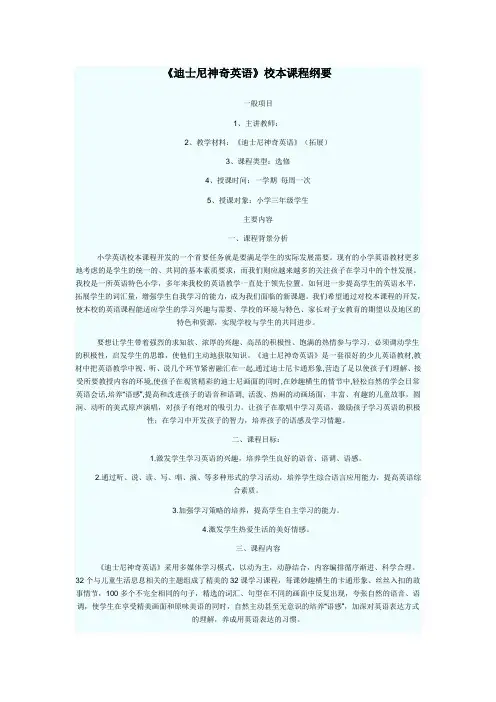
《迪士尼神奇英语》校本课程纲要一般项目1、主讲教师:2、教学材料:《迪士尼神奇英语》(拓展)3、课程类型:选修4、授课时间:一学期每周一次5、授课对象:小学三年级学生主要内容一、课程背景分析小学英语校本课程开发的一个首要任务就是要满足学生的实际发展需要。
现有的小学英语教材更多地考虑的是学生的统一的、共同的基本素质要求,而我们则应越来越多的关注孩子在学习中的个性发展。
我校是一所英语特色小学,多年来我校的英语教学一直处于领先位置。
如何进一步提高学生的英语水平,拓展学生的词汇量,增强学生自我学习的能力,成为我们面临的新课题。
我们希望通过对校本课程的开发,使本校的英语课程能适应学生的学习兴趣与需要、学校的环境与特色、家长对子女教育的期望以及地区的特色和资源,实现学校与学生的共同进步。
要想让学生带着强烈的求知欲、浓厚的兴趣、高昂的积极性、饱满的热情参与学习,必须调动学生的积极性,启发学生的思维,使他们主动地获取知识。
《迪士尼神奇英语》是一套很好的少儿英语教材,教材中把英语教学中视、听、说几个环节紧密融汇在一起,通过迪士尼卡通形象,营造了足以使孩子们理解、接受所要教授内容的环境,使孩子在观赏精彩的迪士尼画面的同时,在妙趣横生的情节中,轻松自然的学会日常英语会话,培养“语感”,提高和改进孩子的语音和语调, 活泼、热闹的动画场面,丰富、有趣的儿童故事,圆润、动听的美式原声演唱,对孩子有绝对的吸引力。
让孩子在歌唱中学习英语,激励孩子学习英语的积极性;在学习中开发孩子的智力,培养孩子的语感及学习情趣。
二、课程目标:1.激发学生学习英语的兴趣,培养学生良好的语音、语调、语感。
2.通过听、说、读、写、唱、演、等多种形式的学习活动,培养学生综合语言应用能力,提高英语综合素质。
3.加强学习策略的培养,提高学生自主学习的能力。
4.激发学生热爱生活的美好情感。
三、课程内容《迪士尼神奇英语》采用多媒体学习模式,以动为主,动静结合,内容编排循序渐进、科学合理。
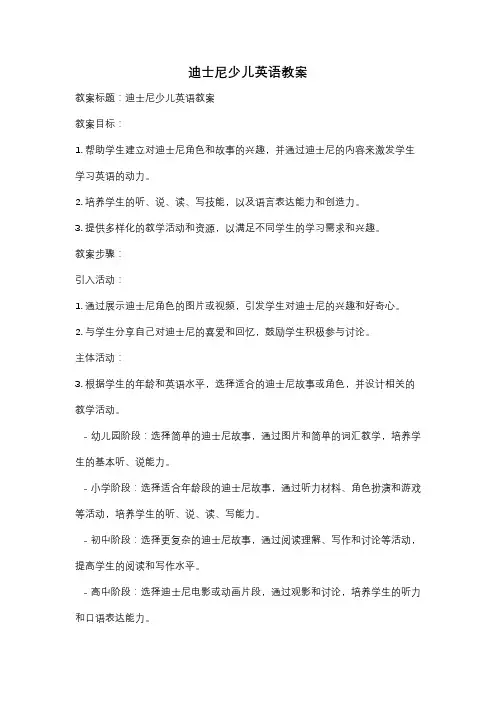
迪士尼少儿英语教案教案标题:迪士尼少儿英语教案教案目标:1. 帮助学生建立对迪士尼角色和故事的兴趣,并通过迪士尼的内容来激发学生学习英语的动力。
2. 培养学生的听、说、读、写技能,以及语言表达能力和创造力。
3. 提供多样化的教学活动和资源,以满足不同学生的学习需求和兴趣。
教案步骤:引入活动:1. 通过展示迪士尼角色的图片或视频,引发学生对迪士尼的兴趣和好奇心。
2. 与学生分享自己对迪士尼的喜爱和回忆,鼓励学生积极参与讨论。
主体活动:3. 根据学生的年龄和英语水平,选择适合的迪士尼故事或角色,并设计相关的教学活动。
- 幼儿园阶段:选择简单的迪士尼故事,通过图片和简单的词汇教学,培养学生的基本听、说能力。
- 小学阶段:选择适合年龄段的迪士尼故事,通过听力材料、角色扮演和游戏等活动,培养学生的听、说、读、写能力。
- 初中阶段:选择更复杂的迪士尼故事,通过阅读理解、写作和讨论等活动,提高学生的阅读和写作水平。
- 高中阶段:选择迪士尼电影或动画片段,通过观影和讨论,培养学生的听力和口语表达能力。
4. 创设情境和角色扮演活动,让学生在真实的语言环境中运用所学的英语知识,提高语言表达能力和创造力。
评估活动:5. 设计针对不同学习目标的评估活动,如听力理解测试、口语表达任务、阅读理解题目等,以便及时了解学生的学习进展并提供反馈。
拓展活动:6. 提供额外的学习资源和拓展活动,如迪士尼英语绘本、歌曲、游戏和网上资源等,鼓励学生在课堂之外继续学习和探索。
教案评估:7. 教师应根据学生的表现和学习成果,评估教案的有效性和适应性,并根据评估结果进行调整和改进。
教案指导:8. 教师应根据学生的年龄、英语水平和学习需求,灵活调整教案的内容和活动,以确保教学的有效性和学生的参与度。
9. 教师可以根据学生的兴趣和喜好,选择适合的迪士尼故事和角色,以提高学生的学习动力和兴趣。
10. 教师应提供足够的支持和指导,鼓励学生主动参与活动,培养他们的自主学习能力和创造力。
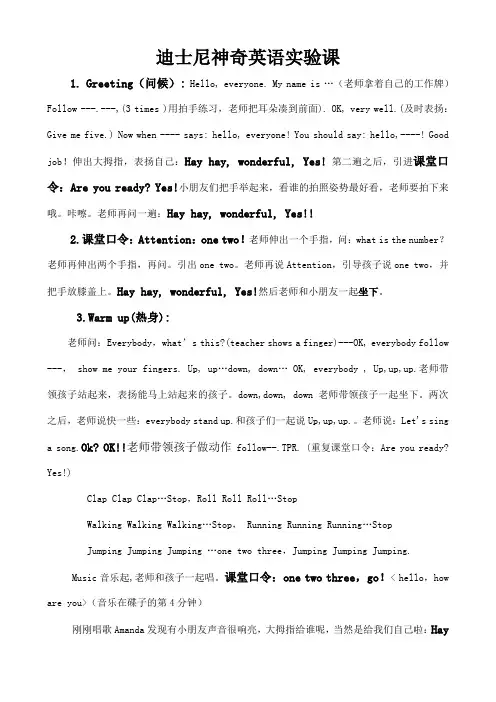
迪士尼神奇英语实验课1. Greeting(问候): Hello, everyone. My name is …(老师拿着自己的工作牌)Follow ---.---,(3 times )用拍手练习,老师把耳朵凑到前面). OK, very well.(及时表扬:Give me five.) Now when ---- says: hello, everyone! You should say: hello,----! Good job!伸出大拇指,表扬自己:Hay hay, wonderful, Yes!第二遍之后,引进课堂口令:Are you ready? Yes!小朋友们把手举起来,看谁的拍照姿势最好看,老师要拍下来哦。
咔嚓。
老师再问一遍:Hay hay, wonderful, Yes!!2.课堂口令:Attention:one two!老师伸出一个手指,问:what is the number?老师再伸出两个手指,再问。
引出one two。
老师再说Attention,引导孩子说one two,并把手放膝盖上。
Hay hay, wonderful, Yes!然后老师和小朋友一起坐下。
3.Warm up(热身):老师问:Everybody,what’s this?(teacher shows a finger)---OK, everybody follow ---,show me your fingers. Up, up…down, down… OK, everybody , Up,up,up.老师带领孩子站起来,表扬能马上站起来的孩子。
down,down, down 老师带领孩子一起坐下。
两次之后,老师说快一些:everybody stand up.和孩子们一起说Up,up,up.。
老师说:Let's sing a song.Ok? OK!!老师带领孩子做动作 follow--.TPR. (重复课堂口令:Are you ready? Yes!)Clap Clap Clap…Stop,Roll Roll Roll…StopWalking Walking Walking…Stop, Running Running Running…StopJumping Jumping Jumping …one two three,Jumping Jumping Jumping.Music音乐起,老师和孩子一起唱。
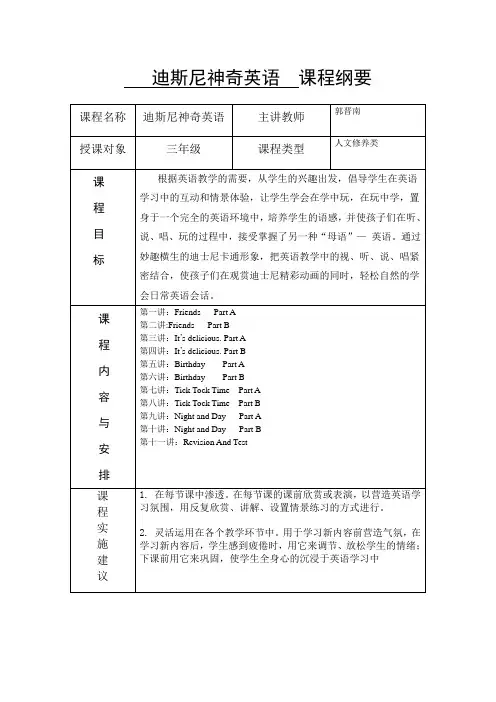
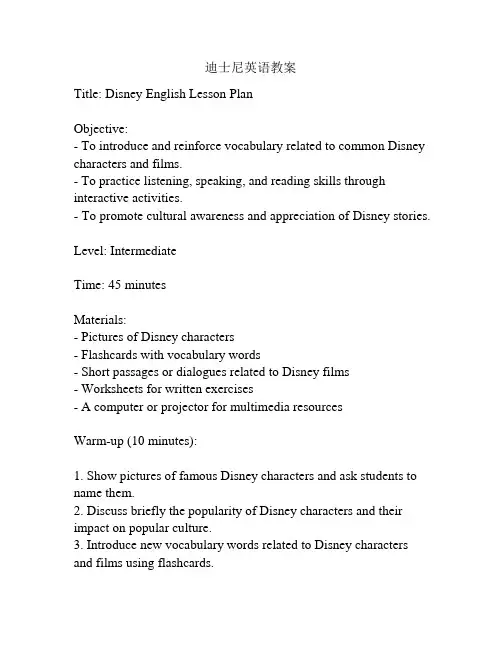
迪士尼英语教案Title: Disney English Lesson PlanObjective:- To introduce and reinforce vocabulary related to common Disney characters and films.- To practice listening, speaking, and reading skills through interactive activities.- To promote cultural awareness and appreciation of Disney stories. Level: IntermediateTime: 45 minutesMaterials:- Pictures of Disney characters- Flashcards with vocabulary words- Short passages or dialogues related to Disney films- Worksheets for written exercises- A computer or projector for multimedia resourcesWarm-up (10 minutes):1. Show pictures of famous Disney characters and ask students to name them.2. Discuss briefly the popularity of Disney characters and their impact on popular culture.3. Introduce new vocabulary words related to Disney characters and films using flashcards.Main Activities (30 minutes):1. Listening Comprehension:- Play an audio clip or a short scene from a Disney film.- Ask students to listen carefully and answer questions about what they heard.- Encourage students to discuss their answers in pairs before sharing with the whole class.2. Vocabulary Matching:- Distribute worksheets with a list of vocabulary words and corresponding definitions.- Have students match the words with their correct definitions. - Review the answers together as a class.3. Reading Practice:- Provide short passages or dialogues related to Disney films (e.g., a conversation between Mickey and Minnie Mouse).- Ask students to read the passage silently and then answer comprehension questions.- Allow time for students to discuss their answers in small groups before sharing as a class.4. Speaking Activity:- Divide students into small groups and assign each group a specific Disney film.- Give each group a scenario or prompt related to their assigned film.- Have students discuss and role-play the scenario, using the vocabulary words and phrases learned earlier.- Encourage creativity and interaction among group members. Wrap-up (5 minutes):1. Review the vocabulary words learned during the lesson. Ask students to provide examples or use them in sentences to reinforce understanding.2. Discuss briefly the cultural relevance and impact of Disney films in different parts of the world.3. Assign a short written exercise or homework related to the lesson material, such as writing a short paragraph about their favorite Disney character or film.Extension/Additional Activities:- Create a Disney trivia game or quiz to test students' knowledge of Disney characters and films.- Have students design their own Disney character and write a short description of its personality and story.- Show a short animated Disney film and facilitate a class discussion about the themes, messages, and lessons conveyed in the story.Note: Adapt the lesson activities and materials to suit the needs and abilities of your students.。
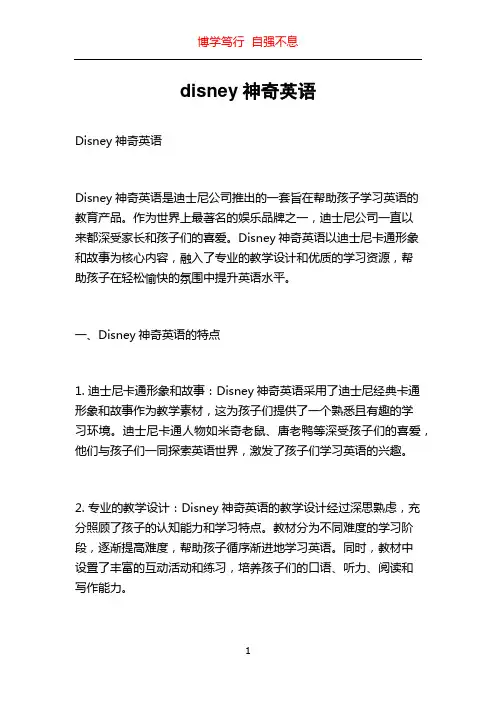
disney神奇英语Disney神奇英语Disney神奇英语是迪士尼公司推出的一套旨在帮助孩子学习英语的教育产品。
作为世界上最著名的娱乐品牌之一,迪士尼公司一直以来都深受家长和孩子们的喜爱。
Disney神奇英语以迪士尼卡通形象和故事为核心内容,融入了专业的教学设计和优质的学习资源,帮助孩子在轻松愉快的氛围中提升英语水平。
一、Disney神奇英语的特点1. 迪士尼卡通形象和故事:Disney神奇英语采用了迪士尼经典卡通形象和故事作为教学素材,这为孩子们提供了一个熟悉且有趣的学习环境。
迪士尼卡通人物如米奇老鼠、唐老鸭等深受孩子们的喜爱,他们与孩子们一同探索英语世界,激发了孩子们学习英语的兴趣。
2. 专业的教学设计:Disney神奇英语的教学设计经过深思熟虑,充分照顾了孩子的认知能力和学习特点。
教材分为不同难度的学习阶段,逐渐提高难度,帮助孩子循序渐进地学习英语。
同时,教材中设置了丰富的互动活动和练习,培养孩子们的口语、听力、阅读和写作能力。
3. 优质的学习资源:Disney神奇英语提供了丰富多样的学习资源,包括教材、音频、视频和互动游戏等。
教材内容涵盖了日常生活、自然环境、社交交往等多个场景,且经过专业教师的录制和编辑,确保教学质量。
音频和视频资源提供了真实的语言输入和模仿的机会,帮助孩子们提高口语和听力能力。
互动游戏则激发了孩子们的学习兴趣,增加了学习的乐趣。
二、Disney神奇英语的教学方法1. 情境教学:Disney神奇英语以真实的生活情境为基础,通过故事和对话的形式,让孩子们在语言环境中学习。
例如,在教学材料中会插入餐厅、购物、旅游等场景,让孩子们学会如何应对真实的英语交流情境。
2. 游戏化教学:Disney神奇英语通过各种互动游戏,如听力游戏、语音游戏、拼图游戏等,激发孩子们的学习兴趣,增加学习的趣味性。
游戏化教学不仅能提高孩子们的动手能力,还能培养他们的合作精神和竞争意识。
3. 多媒体辅助教学:Disney神奇英语提供了丰富的音频和视频资源,辅助孩子们学习英语。
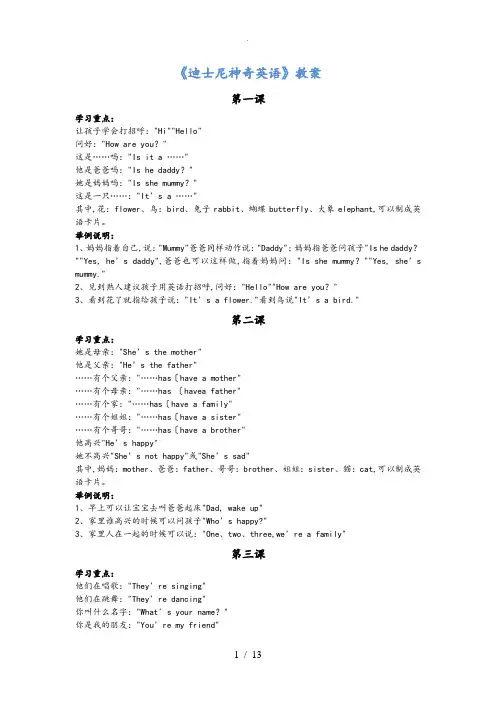
《迪士尼神奇英语》教案第一课学习重点:让孩子学会打招呼:"Hi""Hello"问好:"How are you?"这是……吗:"Is it a ……"他是爸爸吗:"Is he daddy?"她是妈妈吗:"Is she mummy?"这是一只……:"It’s a ……"其中,花:flower、鸟:bird、兔子rabbit、蝴蝶butterfly、大象elephant,可以制成英语卡片。
举例说明:1、妈妈指着自己,说:"Mummy"爸爸同样动作说:"Daddy";妈妈指爸爸问孩子"Is he daddy?""Yes, he’s daddy",爸爸也可以这样做,指着妈妈问:"Is she mummy?""Yes, she’s mummy."2、见到熟人建议孩子用英语打招呼,问好:"Hello""How are you?"3、看到花了就指给孩子说:"It’s a flower."看到鸟说"It’s a bird."第二课学习重点:她是母亲:"She’s the mother"他是父亲:"He’s the father"……有个父亲:"……has〔have a mother"……有个母亲:"……has 〔havea father"……有个家:"……has〔have a family"……有个姐姐:"……has〔have a sister"……有个哥哥:"……has〔have a brother"他高兴"He’s happy"她不高兴"She’s not happy"或"She’s sad"其中,妈妈:mother、爸爸:father、哥哥:brother、姐姐:sister、猫:cat,可以制成英语卡片。
迪士尼神奇英语magic english(实用版)目录1.迪士尼神奇英语介绍2.迪士尼神奇英语的课程设置3.迪士尼神奇英语的教学方法4.迪士尼神奇英语的优点和缺点5.迪士尼神奇英语的适合对象正文迪士尼神奇英语,又称为 Magic English,是由迪士尼公司推出的一套英语学习教程。
该教程旨在通过生动有趣的故事和角色,以及先进的教学方法,帮助学生轻松地学习英语。
首先,让我们来看一下迪士尼神奇英语的课程设置。
该教程共分为四个级别,分别是入门级、初级、中级和高级。
每个级别都有对应的课程,从基础的语音、语法到高级的阅读、写作,形成了一个完整的英语学习体系。
其次,迪士尼神奇英语采用了一种非常独特的教学方法。
它利用迪士尼的经典动画和故事,通过角色扮演、情景对话、游戏等方式,让学生在轻松愉快的环境中学习英语。
同时,教程还配备了音频、视频等多媒体资源,让学生可以全方位地学习和练习英语。
然而,迪士尼神奇英语也存在一些优点和缺点。
优点是它的教学方式生动有趣,能够激发学生的学习兴趣和积极性。
同时,它的课程设置系统全面,适合不同水平的学生学习。
缺点是它的教学内容过于依赖迪士尼的故事和角色,可能会缺乏一些实际应用场景。
另外,它的学习资源主要集中在线上,对于一些没有网络或者网络不稳定的地区来说,可能会造成学习困难。
最后,我们来看一下迪士尼神奇英语的适合对象。
由于它的教学内容和方式较为简单有趣,适合初学者和儿童学习。
特别是对于那些喜欢迪士尼故事和角色的孩子来说,迪士尼神奇英语无疑是一种非常有效的学习方式。
总的来说,迪士尼神奇英语是一种非常有趣有效的英语学习方式。
通过生动有趣的故事和角色,以及先进的教学方法,它可以帮助学生轻松地学习英语。
但是,它的教学内容过于依赖迪士尼的故事和角色,可能会缺乏一些实际应用场景。
英语迪士尼电子教案第一章:介绍迪士尼乐园教学目标:1. 让学生了解迪士尼乐园的基本信息和历史。
2. 提高学生的英语听说能力。
教学内容:1. 迪士尼乐园的介绍。
2. 迪士尼乐园的历史。
教学活动:1. 观看迪士尼乐园的介绍视频,让学生了解迪士尼乐园的基本信息。
2. 分组讨论,让学生分享他们所了解的迪士尼乐园的历史。
3. 学生进行角色扮演,模拟向游客介绍迪士尼乐园。
作业:1. 学生回家后,通过网络或书籍查找更多关于迪士尼乐园的信息,并在下节课上与同学分享。
2. 学生写一篇关于迪士尼乐园的短文,描述他们的游览经历。
第二章:迪士尼角色认识教学目标:1. 让学生认识迪士尼乐园中的经典角色。
2. 提高学生的英语听说能力。
教学内容:1. 迪士尼乐园中的经典角色。
2. 角色的特点和故事背景。
教学活动:1. 观看迪士尼角色的介绍视频,让学生认识迪士尼乐园中的经典角色。
2. 分组讨论,让学生分享他们对角色的特点和故事背景的了解。
3. 学生进行角色扮演,模拟向游客介绍迪士尼角色。
作业:1. 学生回家后,通过网络或书籍查找更多关于迪士尼角色的信息,并在下节课上与同学分享。
2. 学生选择一个迪士尼角色,写一篇关于该角色的短文,包括其特点和故事背景。
第三章:迪士尼乐园的游乐设施教学目标:1. 让学生了解迪士尼乐园的游乐设施。
2. 提高学生的英语听说能力。
教学内容:1. 迪士尼乐园的游乐设施类型。
2. 游乐设施的特点和刺激程度。
教学活动:1. 观看迪士尼乐园的游乐设施介绍视频,让学生了解迪士尼乐园的游乐设施类型。
2. 分组讨论,让学生分享他们对游乐设施的特点和刺激程度的了解。
3. 学生进行角色扮演,模拟向游客介绍迪士尼乐园的游乐设施。
作业:1. 学生回家后,通过网络或书籍查找更多关于迪士尼乐园的游乐设施信息,并在下节课上与同学分享。
2. 学生选择一个迪士尼乐园的游乐设施,写一篇关于该设施的短文,包括其特点和刺激程度。
第四章:迪士尼乐园的演出和活动教学目标:1. 让学生了解迪士尼乐园的演出和活动。
英语迪士尼电子教案第一章:介绍迪士尼乐园教学目标:1. 让学生了解迪士尼乐园的基本信息和历史。
2. 提高学生的英语听说能力。
教学内容:1. 介绍迪士尼乐园的创始人、成立时间和地点。
2. 介绍迪士尼乐园的主要景点和娱乐项目。
教学活动:1. 播放迪士尼乐园的介绍视频,让学生听取并翻译。
2. 让学生分组讨论,介绍自己最喜欢的迪士尼乐园景点或娱乐项目。
3. 学生进行角色扮演,模拟在迪士尼乐园的接待处咨询景点和门票情况。
第二章:迪士尼角色认识教学目标:1. 让学生了解迪士尼的主要角色及其特点。
2. 提高学生的英语听力能力和口语表达能力。
教学内容:1. 介绍米老鼠、唐老鸭、灰姑娘等经典迪士尼角色。
2. 介绍迪士尼电影中的新角色。
教学活动:1. 播放迪士尼角色的介绍视频,让学生听取并翻译。
2. 让学生分组讨论,选择自己喜欢的迪士尼角色并介绍其特点。
3. 学生进行角色扮演,模拟在迪士尼乐园与角色合影的情景。
第三章:迪士尼电影欣赏教学目标:1. 让学生了解迪士尼经典电影及其故事情节。
2. 提高学生的英语听说能力和电影欣赏水平。
教学内容:1. 介绍《白雪公主》、《狮子王》、《冰雪奇缘》等迪士尼经典电影。
2. 分析迪士尼电影的主题和价值观。
教学活动:1. 播放迪士尼电影的片段,让学生观看并回答相关问题。
2. 让学生分组讨论,分享自己喜欢的迪士尼电影及其原因。
3. 学生进行角色扮演,模拟在迪士尼乐园的电影院购票和观影情景。
第四章:迪士尼音乐欣赏教学目标:1. 让学生了解迪士尼电影中的经典歌曲及其背后的故事。
2. 提高学生的英语听说能力和音乐欣赏水平。
教学内容:1. 介绍《A Whole New World》、《Let It Go》、《Hakuna Matata》等迪士尼经典歌曲。
2. 分析歌曲的主题和情感表达。
教学活动:1. 播放迪士尼歌曲,让学生聆听并翻译歌词。
2. 让学生分组讨论,选择自己喜欢的迪士尼歌曲并分享其背后的故事。
英语迪士尼电子教案第一章:迪士尼角色认知教学目标:1. 学生能够认识并叫出迪士尼经典角色的名字。
2. 学生能够简单描述迪士尼角色的特征和性格。
教学内容:1. 介绍米老鼠、唐老鸭、灰姑娘、白雪公主等经典迪士尼角色。
2. 通过图片和视频,帮助学生熟悉并认知这些角色。
教学活动:1. 展示迪士尼角色的图片,让学生尝试说出他们的名字。
2. 播放迪士尼角色的视频,让学生描述他们的特征和性格。
第二章:迪士尼故事理解教学目标:1. 学生能够理解并简单复述迪士尼经典故事的情节。
2. 学生能够通过故事学习到一些基本的道德观念和价值观。
教学内容:1. 讲解《白雪公主》、《灰姑娘》、《美女与野兽》等经典迪士尼故事的情节。
2. 通过故事,引导学生学习到一些基本的道德观念和价值观。
教学活动:1. 讲解迪士尼故事的情节,让学生简单复述故事的主要内容。
2. 讨论故事中的道德观念和价值观,让学生学会正确的人生观和价值观。
第三章:迪士尼歌曲学唱教学目标:1. 学生能够学会并唱出迪士尼经典歌曲。
2. 学生能够通过歌曲学习到一些基本的英语单词和句型。
教学内容:1. 教唱《小小世界》、《奇妙世界》、《梦想成真》等经典迪士尼歌曲。
2. 通过歌曲,让学生学习到一些基本的英语单词和句型。
教学活动:1. 教唱迪士尼歌曲,让学生学会歌曲中的单词和句型。
2. 举办歌曲比赛,让学生展示他们学唱的歌曲。
第四章:迪士尼电影欣赏教学目标:1. 学生能够理解并欣赏迪士尼电影的精彩片段。
2. 学生能够通过电影学习到一些基本的英语表达和口语技巧。
教学内容:1. 欣赏迪士尼电影的精彩片段,如《狮子王》、《冰雪奇缘》等。
2. 通过电影,让学生学习到一些基本的英语表达和口语技巧。
教学活动:1. 播放迪士尼电影的精彩片段,让学生欣赏并理解故事情节。
2. 模仿电影中的英语表达和口语技巧,进行角色扮演和口语练习。
第五章:迪士尼主题活动教学目标:1. 学生能够通过参与迪士尼主题活动,提高自己的动手能力和创造力。
迪士尼小学英语教学设计摘要:迪士尼小学英语教学设计是一种基于迪士尼动画片的英语教学方法。
它以迪士尼动画片为教材,并将角色、情节和音乐结合起来进行教学。
本文介绍了迪士尼小学英语教学设计的原则、步骤以及实施的效果。
1. 引言迪士尼动画片是全球孩子们喜爱的动画片之一。
它以丰富多彩的角色和精彩的情节受到了广大儿童的喜爱,并且具有很高的教育价值。
因此,许多教师开始将迪士尼动画片融入到英语教学中,以增加学生的学习兴趣和积极性。
2. 迪士尼小学英语教学设计的原则迪士尼小学英语教学设计的原则主要包括以下几点:2.1 融入角色和情节在迪士尼小学英语教学设计中,教师可以选择一个迪士尼动画片来进行教学。
教师可以通过让学生扮演迪士尼动画片中的角色来进行练习,这样能够激发学生的学习兴趣和参与度。
同时,教师还可以以迪士尼动画片中的情节为基础设计教学活动,让学生在情节中学习和掌握英语知识。
2.2 结合音乐迪士尼动画片中经典的音乐也是其受欢迎的重要原因之一。
在迪士尼小学英语教学设计中,教师可以选取一些与教学内容相关的迪士尼动画片的音乐,并让学生一起欣赏和学唱。
这样能够增加学生对英语的兴趣,培养学生的听力和口语能力。
2.3 创设情境在迪士尼小学英语教学设计中,教师可以通过创设情境,让学生身临其境地学习和使用英语。
例如,教师可以选择一个迪士尼动画片中的场景,然后让学生在这个场景中使用英语进行对话和表演。
这样能够提高学生的口语表达能力和交际能力。
3. 迪士尼小学英语教学设计的步骤迪士尼小学英语教学设计的步骤主要包括以下几点:3.1 确定教学目标教师首先需要明确教学目标。
根据学生的年龄和英语水平,教师可以确定适合的教学内容和目标。
例如,教师可以选择一部与单词和句子结构相关的迪士尼动画片来进行教学。
3.2 选择教材教师可以选择一个适合的迪士尼动画片作为教材。
教师可以为学生精心选择一些有趣的片段,并从中提取一些重要的单词和句子结构作为教学重点。
第一课学习重点:让孩子学会打招呼:“Hi ”“Hello ”问好:“How are you?”这是……吗:“Is it a ……”他是爸爸吗:“Is he daddy?”她是妈妈吗:“Is she mummy?”这是一只……:“It ’s a ……”其中,花:flower 、鸟:bird 、兔子rabbit 、蝴蝶butterfly 、大象elephant ,可以制成英语卡片。
举例说明:1、妈妈指着自己,说:“Mummy ”爸爸同样动作说:“Daddy ”;妈妈指爸爸问孩子“Is he daddy ?”“Yes, he’s daddy”,爸爸也可以这样做,指着妈妈问:“Is she mummy?”“Yes, she’s mummy. ”2、见到熟人建议孩子用英语打招呼,问好:“Hello ”“How are you?”3、看到花了就指给孩子说:“It ’s a flower.”看到鸟说“It ’s a bird.”第二课学习重点:她是母亲:“She ’s the mother”他是父亲:“He ’s the father”……有个父亲:“……has (have ) a mo ther”……有个母亲:“……has (have )a father”……有个家:“……has (have ) a family”……有个姐姐:“……has (have ) a sister”……有个哥哥:“……has (have ) a brother”他高兴“He ’s happy”她不高兴“She ’s not happy”或“She ’s sad”其中,妈妈:mother 、爸爸:father 、哥哥:brother 、姐姐:sister 、猫:cat ,可以制成英语卡片。
举例说明:1、早上可以让宝宝去叫爸爸起床“Dad, wake up”2、家里谁高兴的时候可以问孩子“Who ’s happy?”3、家里人在一起的时候可以说:“One 、two 、three,we ’re a family”第三课1预览:学习重点:他们在唱歌:“They’re singing”他们在跳舞:“They’re dancing”你叫什么名字:“What ’s your name?”你是我的朋友:“You ’re my friend”我是你的朋友:“I ’m your friend”他是谁:“Who ’s he”?其中:跳舞: dance 、唱歌:sing 、玩:play 、跑:run 、游泳:swim 、狗:dog ,可以制成英语卡片。
举例说明:1、家里人可以互相问名字:“What ’s your name?”2、爸爸,妈妈和宝宝一起跳舞,唱歌以后:“We love singing”“We love dancing”3、跟孩子看体育节目的时候:“They ’re running”他们在跑;“They ’re swimming”第四课学习重点:这是一座房子:This is a house.房子有屋顶:The house has a roof.房子有扇窗:The house has a window.房子有一堵墙:The house has a wall.……能飞:……can fly其中,猪:pig 、狼:wolf 、房子:house 、床:bed 、门:door 、钢琴:piano 、烟囱:chimney 、窗:window 、屋顶:roof ,可以制成英语卡片。
举例说明:1、给孩子讲《三只小猪》的故事:They ’re The Pigs(他们是猪);They ’re The Three Pigs(他们是三只小猪) ;The y’re happy(他们很幸福) ;This is a Wolf(这是一只狼);The pigs are afraid(猪们都害怕);He ’s The Big Bad Wolf(他是那只大坏狼)2、跟孩子一起画画,画个房子,在画的过程中跟孩子说:Happy house (快乐的小屋) ;A house with a wall (房子有墙);A house with a door (房子有门); A house with a window(房子有窗户) ;A house with a roof(房子有屋顶) ;A house has a chimney(房子有烟囱)第五课学习重点:我喜欢动物:I love animals.谁喜欢动物:Who is love animals?谁在那里:Who’s there?谁在笑:Who ’s laughing?2预览:谁在睡觉:Who ’s sleeping?谁在讲话:Who ’s talking?晚安:Goodnight……是一种动物:The ……is an animal其中:帽子:hat 、鱼:fish 、动物:animal 、鞋:shoes 、裙子:dress 、睡觉:sleep 、笑:laugh 、讲话:talk ,可以制成英语卡片。
举例说明:1、妈妈睡觉的时候,爸爸可以问孩子:“Who ’s sleeping?”2、家中有人笑的时候,问孩子:“Who ’s laughing?”3、跟孩子玩躲猫猫游戏的时候:“Who ’s there?”4、做一些小动物的头饰,然后每个人扮演一种动物,例如:妈妈头上带小猫的头饰说:“The ca t is an animal”爸爸头上带小狗的头饰说:“The dog is an animal”第六课学习重点:他想吃东西:He wants to eat.这是什么:What ’s this?他在吃什么:What ’s he eating?他在吃东西:He ’s eating.他在喝什么:What is he drinking?水果真好吃:Fruit’s delicious大家都饿了:Everybody’s hungry.其中,汤:soup 、玉米:corn 、细面条:spaghetti 、香蕉:banana 、牛奶:milk 、面包:bread 、蛋糕:cake 、水果:fruit ,可以制成英语卡片。
举例说明:1、跟孩子吃香蕉的时候,可以问孩子:“What ’s this? ”(这是什么)“It ’s a banana ”2、吃饭之前,妈妈可以说:“we are hungry.”(我们都饿了)“we want to eat. ”(我们都想吃东西),家里人一起吃饭的时候,“we are eating.”(我们都在吃东西)3、一起吃面条的时候,可以问孩子:“What ’s this? ”(这是什么)“It ’s spaghetti. ”(这是面条)4、家里面,爷爷奶奶一起喝牛奶的时候,妈妈可以问宝宝:“What are they drinking? ”(他们在喝什么) “They ’re drinking milk.”(他们在喝牛奶)第七课学习重点:这是……的生日吗:Is it ……birthday?一个惊喜:Surprise3预览:这是聚会:This is a party.这是一件礼物:This is a present.一个生日蛋糕:A birthday cake.今天是……的生日:Today is ……birthday他多大年纪了:How old is he?其中:聚会: party;生日快乐:Happy Birthday;可以制成英语卡片。
举例说明:给家里人庆祝生日的时候:It ’s a birthday party(一次生日聚会) ;Happy Birthday to you(祝你生日快乐) ;Here ’s the birthday cake(这是生日蛋糕) ;How old is he(他多大年纪了)(注:其中的‘he ’可用‘she ’‘you ’来代替,How old are you?)第八课学习重点:是吃早餐的时候了:It ’s breakfast time.是去学校的时间了:It ’s school time.是吃午餐的时候了:It ’s lunch time.是做游戏的时间了:It ’s play time.是睡觉的时候了:It ’s bed time.几点了:What time is it?是到了……的时间吗:Is it ……time其中:闹钟:clock ;一点:one o ’clock ;两点:two o ’clock ;三点:three o ’clock ;四点:four o ’clock ;五点:five o ’clock ;六点:six o ’clock ;七点:seven o ’clock ;八点:eight o ’clock ;九点:nine o ’clock ;十点:ten o ’clock ;十一点:eleven o ’clock ;十二点:twelve o’clock ;可以制成英语卡片。
举例说明:1、跟宝宝玩“猜时间的游戏”家长准备一个表,可以随意的调节时间,然后就可以问宝宝:What time is it (几点了);Is it ……time (是到了……的时间吗);It ’s breakfast time (是吃早餐的时候了)(注:其中‘breakfast’可用其它单词代替,例如:lunch(午餐) ,play(游戏) 等等)第九课学习重点:现在是白天吗:Is it day?现在是晚上吗:Is it night?该睡觉了:It ’s bed time.该做游戏了:It ’s time to play.我吃早饭:I eat breakfast.我吃午饭:I eat lunch.4预览:我吃晚饭:I eat dinner.我每天早上洗脸:I wash my face every day.看那月亮:Look at the moon.看那些星星:Look at the stars.其中:月亮:moon ;冷:cold ;晚餐:dinner ;可以制成英语卡片。
举例说明:1、晚上月亮升起来的时候:Look at the moon(看那月亮)2、晚上星星升起来的时候:Look at the stars(看那些星星)3、宝宝睡觉之前:Is it night (现在是晚上吗);It ’s bed time(该睡觉了)4、宝宝刚刚学习完:It ’s time to play(该做游戏了)5、妈妈洗脸的时候,可以对宝宝说:I wash my face every day。
(我每天早上洗脸)第十课学习重点:我们来跳吧:Let ’s jump.我们来跑吧:Let ’s run.让我们笑一笑:Let ’s laugh.我们来玩玩:Let ’s play.其中:冠军:champion 、网球:tennis 、跳高:jump 、走:walk 、高:high 、快:fast 、慢:slow ,可以制成英语卡片。